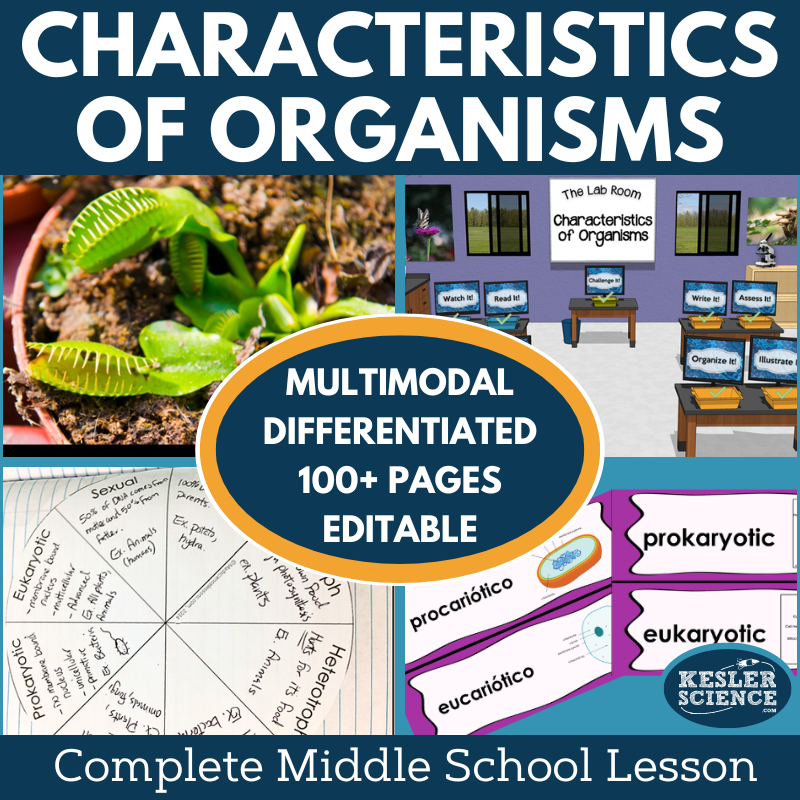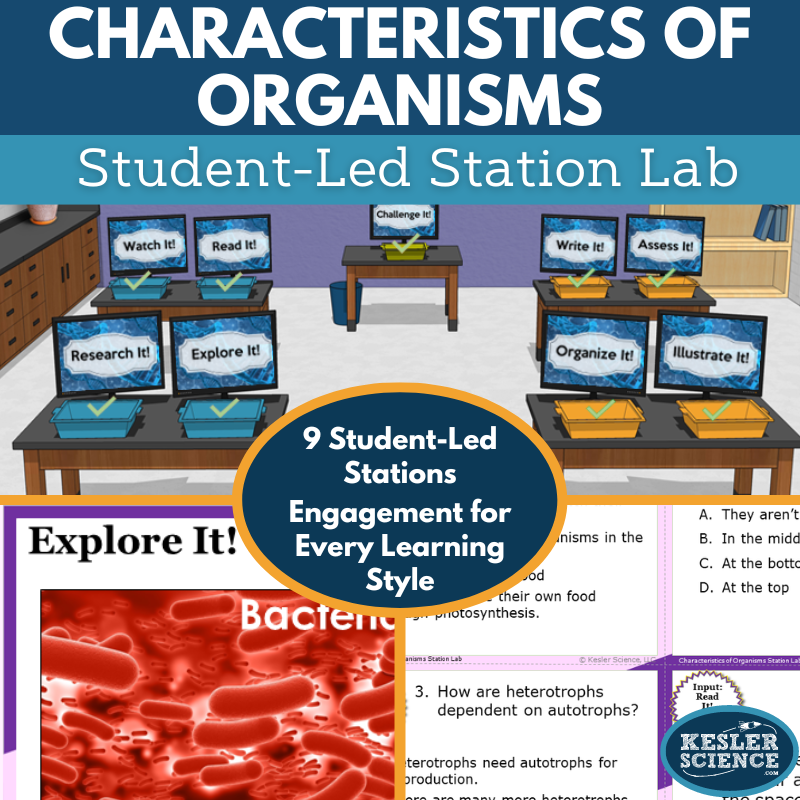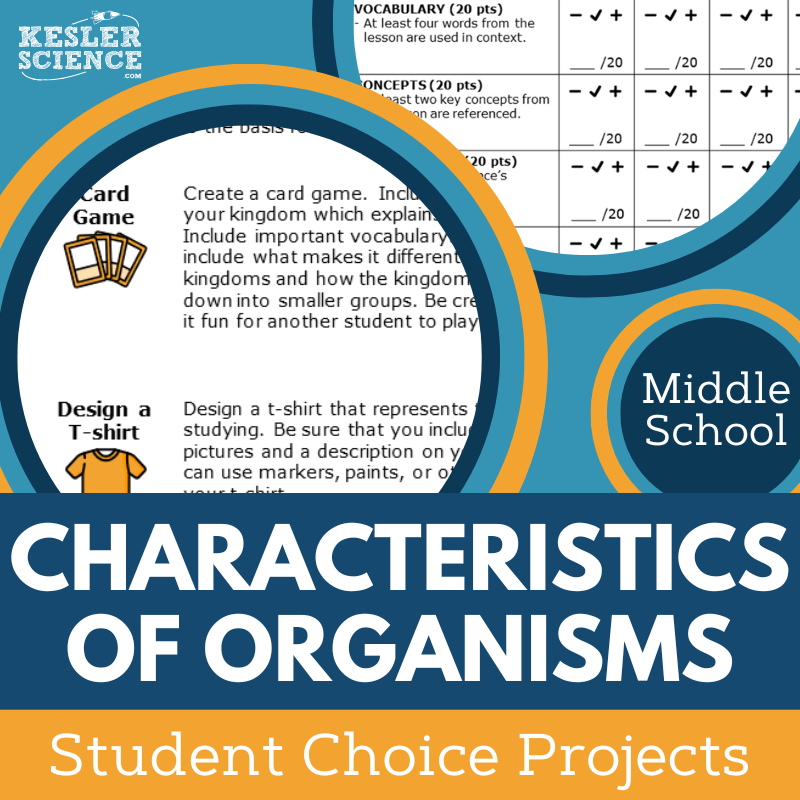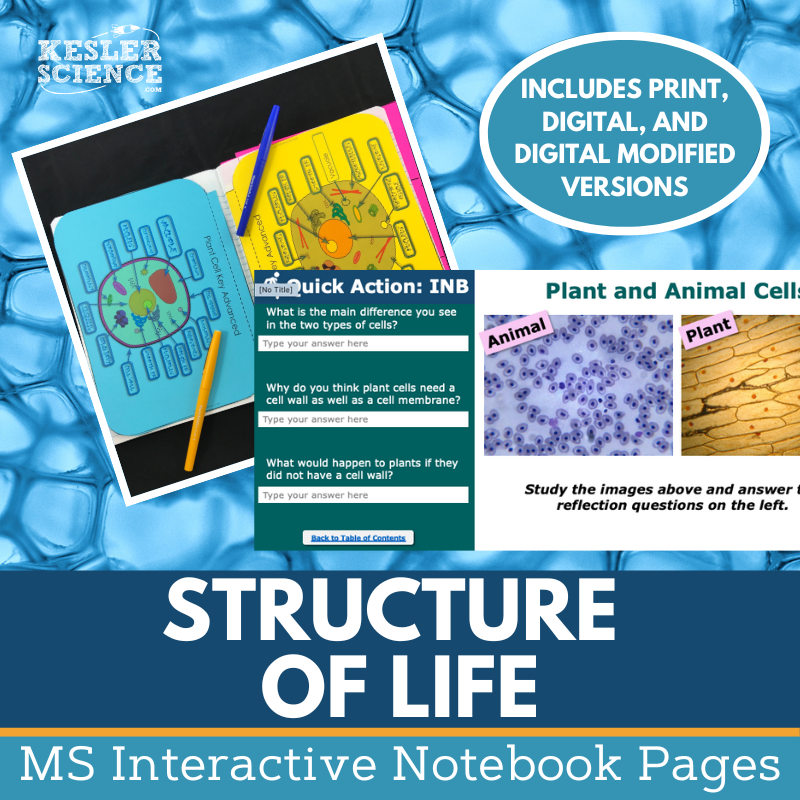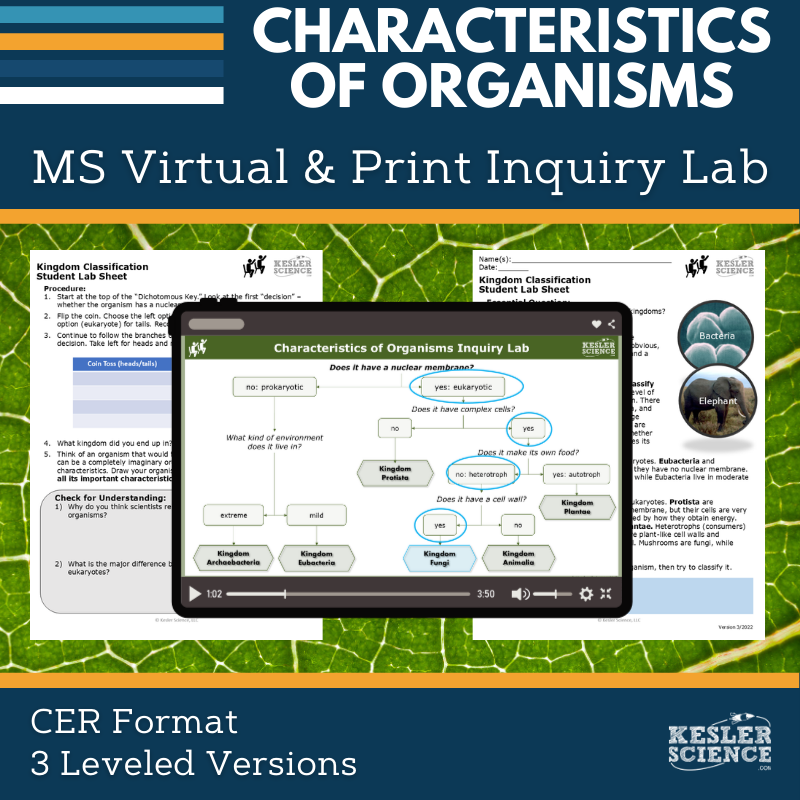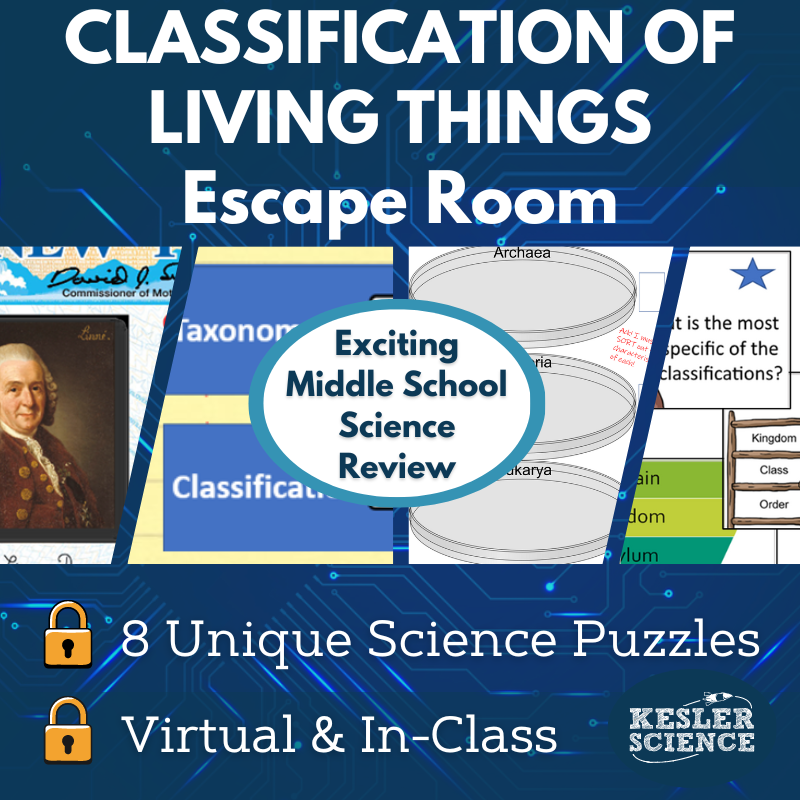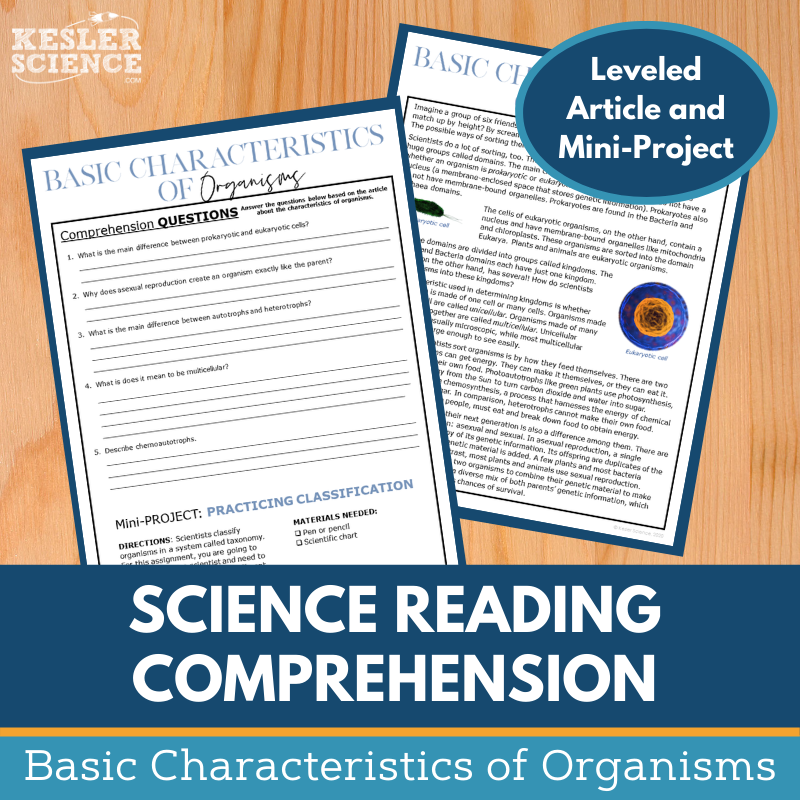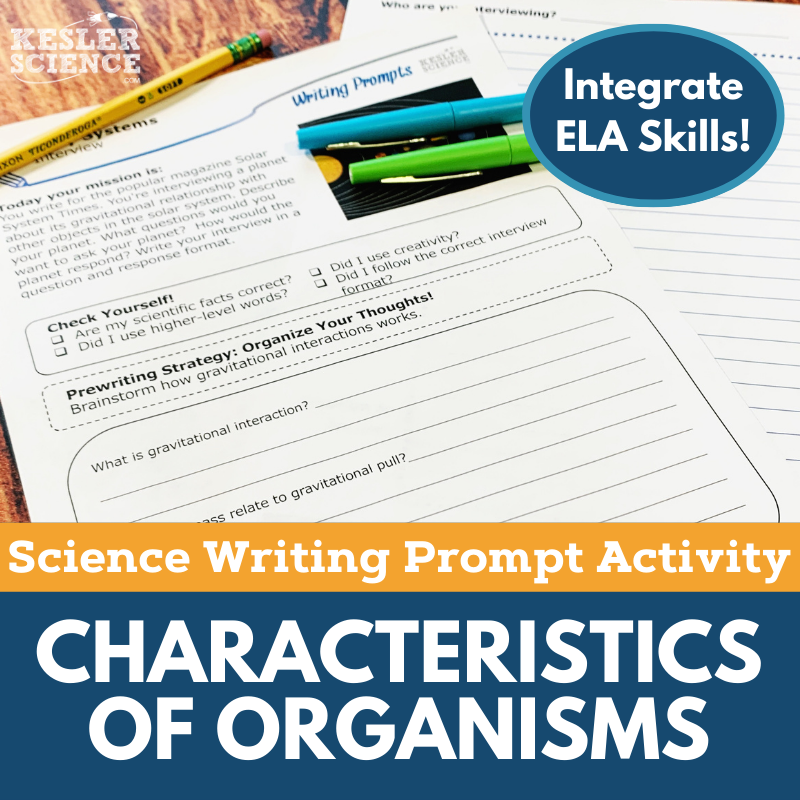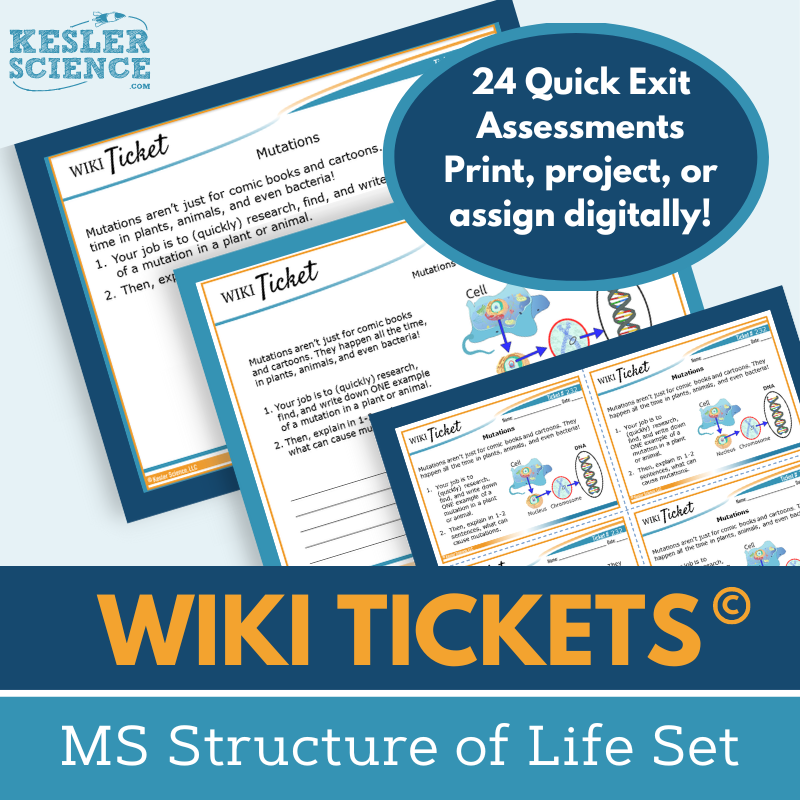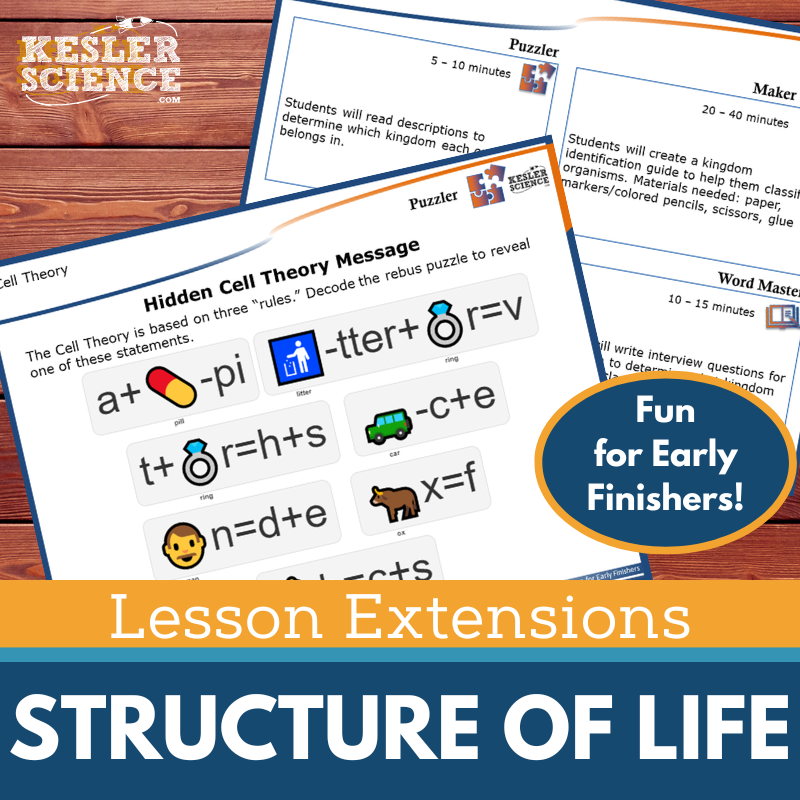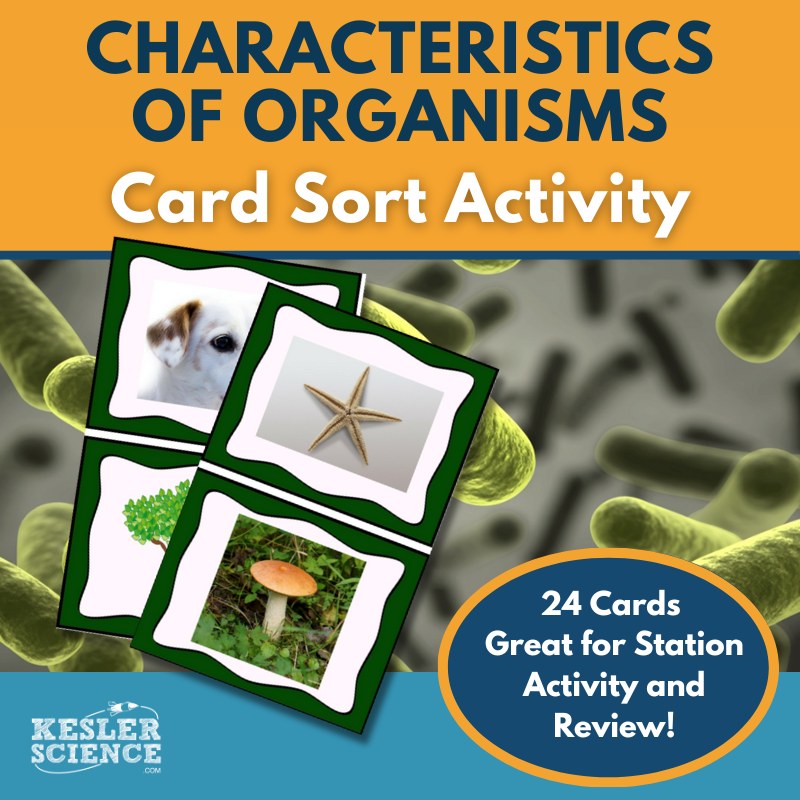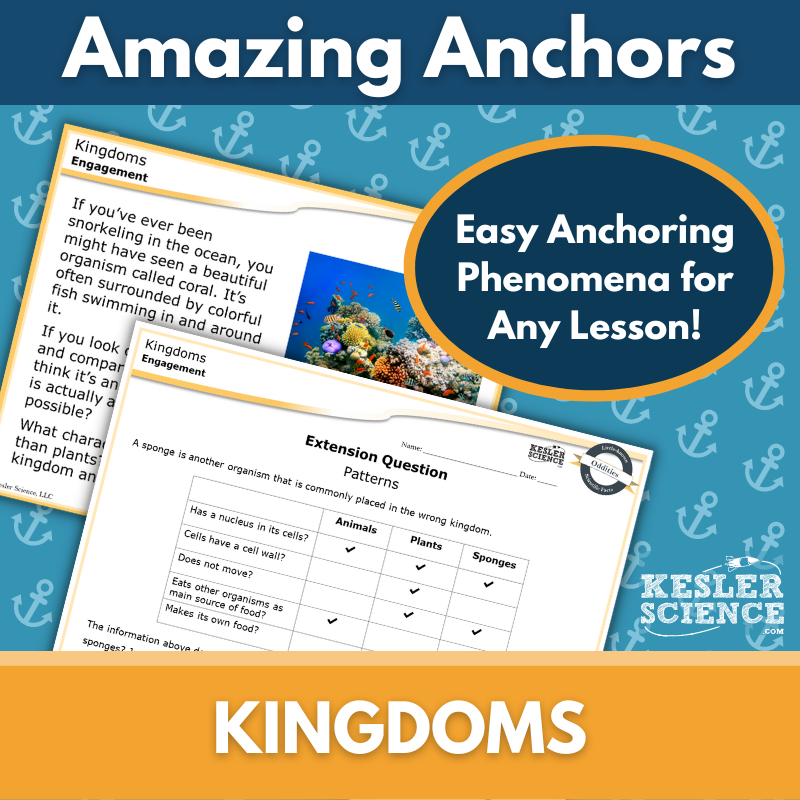Characteristics of Organisms Activities for Middle School Science
The Kesler Science Characteristics of Organisms resources provide comprehensive, engaging materials designed to help middle school students explore and understand the fundamental traits that classify living organisms. The resources below will give students a comprehensive understanding of characteristics of organisms. All of the following materials are also included in the Kesler Science Membership.
The Kesler Science Characteristics of Organisms Complete Lesson follows the 5E Model, providing a structured and engaging experience for middle school students. The lesson includes differentiated materials, multimodal learning options, and flexible formats for both in-person and virtual classrooms. It is designed to help students answer essential questions about the basic characteristics of organisms and how these characteristics help classify organisms into kingdoms. This lesson is perfect for 6th to 8th grade students and offers editable PowerPoints, vocabulary cards in English and Spanish, and student-led exploration.
The Exploration phase includes a station lab with nine differentiated stations, allowing students to engage with the content in various ways. Input stations such as "Explore It!" and "Research It!" introduce new concepts through hands-on activities, reading, and web research, while output stations like "Illustrate It!" and "Write It!" provide opportunities for students to showcase their understanding. A bonus "Challenge It!" station offers advanced learners additional reinforcement and fun extension activities.
In the Explanation phase, students benefit from editable PowerPoints, interactive notebook templates, and note-taking guides to support their learning. The Elaboration phase includes student-choice projects to extend the lesson beyond the classroom. Evaluation materials such as assessment questions, review sheets, and worksheets ensure that students have mastered the content. This complete lesson package is perfect for both classroom and remote learning environments, offering a dynamic, student-centered approach to understanding the characteristics of organisms.
The Kesler Science Characteristics of Organisms Complete Lesson follows the 5E Model, providing a structured and engaging experience for middle school students. The lesson includes differentiated materials, multimodal learning options, and flexible formats for both in-person and virtual classrooms. It is designed to help students answer essential questions about the basic characteristics of organisms and how these characteristics help classify organisms into kingdoms. This lesson is perfect for 6th to 8th grade students and offers editable PowerPoints, vocabulary cards in English and Spanish, and student-led exploration.
The Exploration phase includes a station lab with nine differentiated stations, allowing students to engage with the content in various ways. Input stations such as "Explore It!" and "Research It!" introduce new concepts through hands-on activities, reading, and web research, while output stations like "Illustrate It!" and "Write It!" provide opportunities for students to showcase their understanding. A bonus "Challenge It!" station offers advanced learners additional reinforcement and fun extension activities.
In the Explanation phase, students benefit from editable PowerPoints, interactive notebook templates, and note-taking guides to support their learning. The Elaboration phase includes student-choice projects to extend the lesson beyond the classroom. Evaluation materials such as assessment questions, review sheets, and worksheets ensure that students have mastered the content. This complete lesson package is perfect for both classroom and remote learning environments, offering a dynamic, student-centered approach to understanding the characteristics of organisms.
The Kesler Science Characteristics of Organisms Station Lab is a student-led, modular activity that immerses middle school students in exploring the characteristics of organisms. With eight differentiated stations and a bonus challenge station for advanced learners, students direct their learning while the teacher facilitates and provides support. This engaging, hands-on approach allows students to work independently or in small groups, making the lesson adaptable to different learning styles.
The station lab includes both input and output stations to support a comprehensive learning experience. Input stations like "Explore It!" and "Read It!" allow students to investigate new concepts through interactive activities, readings, and videos. In output stations like "Illustrate It!" and "Assess It!", students organize and communicate their understanding by creating visual representations and responding to task cards that demonstrate their mastery of the topic.
Designed for flexibility, this resource is differentiated for diverse learning needs and is available in both print and digital formats. The digital version can be used for remote learning, enabling students to complete tasks and manipulate images using platforms like PowerPoint and Google Slides, ensuring an engaging experience regardless of the learning environment.
The Kesler Science Characteristics of Organisms Station Lab is a student-led, modular activity that immerses middle school students in exploring the characteristics of organisms. With eight differentiated stations and a bonus challenge station for advanced learners, students direct their learning while the teacher facilitates and provides support. This engaging, hands-on approach allows students to work independently or in small groups, making the lesson adaptable to different learning styles.
The station lab includes both input and output stations to support a comprehensive learning experience. Input stations like "Explore It!" and "Read It!" allow students to investigate new concepts through interactive activities, readings, and videos. In output stations like "Illustrate It!" and "Assess It!", students organize and communicate their understanding by creating visual representations and responding to task cards that demonstrate their mastery of the topic.
Designed for flexibility, this resource is differentiated for diverse learning needs and is available in both print and digital formats. The digital version can be used for remote learning, enabling students to complete tasks and manipulate images using platforms like PowerPoint and Google Slides, ensuring an engaging experience regardless of the learning environment.
The Kesler Science Characteristics of Organisms Student Choice Project offers middle school students the opportunity to select a project that matches their learning style. With six project options and a “design your own” choice, students can demonstrate their understanding creatively. A grading rubric is provided for teachers, peers, or self-assessment, and teachers can modify it to fit their grading needs.
The project offers flexibility with nine project choices and a “design your own” option, making it adaptable for various learning levels. It includes a Teacher Directions page with support and suggestions, and an editable rubric that assesses vocabulary, concepts, presentation, clarity, and accuracy. Differentiated versions are available, with modified options for students needing extra support and challenge combinations for advanced learners.
Designed for ease, the projects require minimal supplies like paper, markers, and scissors, with many options available for digital completion. Some projects may require crafting materials for hands-on models. This adaptable resource allows teachers to accommodate all learners and fosters creative, personalized learning.
The Kesler Science Characteristics of Organisms Student Choice Project offers middle school students the opportunity to select a project that matches their learning style. With six project options and a “design your own” choice, students can demonstrate their understanding creatively. A grading rubric is provided for teachers, peers, or self-assessment, and teachers can modify it to fit their grading needs.
The project offers flexibility with nine project choices and a “design your own” option, making it adaptable for various learning levels. It includes a Teacher Directions page with support and suggestions, and an editable rubric that assesses vocabulary, concepts, presentation, clarity, and accuracy. Differentiated versions are available, with modified options for students needing extra support and challenge combinations for advanced learners.
Designed for ease, the projects require minimal supplies like paper, markers, and scissors, with many options available for digital completion. Some projects may require crafting materials for hands-on models. This adaptable resource allows teachers to accommodate all learners and fosters creative, personalized learning.
The Kesler Science Structure of Life Interactive Notebook Bundle provides an engaging way for students to explore life science concepts through interactive activities. Designed for both print and digital use, this resource is perfect for traditional classrooms, 1:1 environments, and distance learning. Topics covered include cell theory, characteristics of organisms, plant and animal cells, and more, offering a comprehensive tool for teaching the structure of life.
The digital version includes a unique interactive notebook PowerPoint that can be uploaded to platforms like Google Slides or MS Teams, complete with reflection pages, note spaces, and an answer key. A modified digital version is also provided for students needing accommodations. The paper version features blank and pre-filled templates, along with color photos to guide usage, ensuring all students can participate effectively.
With resources tailored for diverse learning needs, the Kesler Science Structure of Life Interactive Notebook Bundle supports differentiated instruction and student-centered learning. Teachers gain a versatile tool for enhancing understanding, while students build lasting connections to key life science concepts.
The Kesler Science Structure of Life Interactive Notebook Bundle provides an engaging way for students to explore life science concepts through interactive activities. Designed for both print and digital use, this resource is perfect for traditional classrooms, 1:1 environments, and distance learning. Topics covered include cell theory, characteristics of organisms, plant and animal cells, and more, offering a comprehensive tool for teaching the structure of life.
The digital version includes a unique interactive notebook PowerPoint that can be uploaded to platforms like Google Slides or MS Teams, complete with reflection pages, note spaces, and an answer key. A modified digital version is also provided for students needing accommodations. The paper version features blank and pre-filled templates, along with color photos to guide usage, ensuring all students can participate effectively.
With resources tailored for diverse learning needs, the Kesler Science Structure of Life Interactive Notebook Bundle supports differentiated instruction and student-centered learning. Teachers gain a versatile tool for enhancing understanding, while students build lasting connections to key life science concepts.
The Kesler Science Characteristics of Organisms Inquiry Lab helps students explore how scientists classify organisms into kingdoms by engaging them in both digital and hands-on activities. In this lab, students create imaginary organisms that fit within existing kingdoms, then trade and identify them using classification criteria. Advanced learners extend their understanding by comparing protists and researching animal phyla.
Both the digital and print formats of this lab include differentiated versions—Dependent, Modified, and Independent—catering to a range of learning needs. Each version features comprehension questions, Claim-Evidence-Reasoning (C.E.R.) prompts, and reflection sections to guide students through the scientific process. The print lab requires basic supplies like colored pencils and a coin, while the digital version includes all interactive elements within the file itself.
Teachers benefit from editable materials that are compatible with Google Slides and PowerPoint. Resources include teacher directions, answer keys, standards, and prep information, allowing for maximum flexibility in instruction. Whether used in the classroom or virtually, this lab promotes student engagement and supports multimodal learning.
The Kesler Science Characteristics of Organisms Inquiry Lab helps students explore how scientists classify organisms into kingdoms by engaging them in both digital and hands-on activities. In this lab, students create imaginary organisms that fit within existing kingdoms, then trade and identify them using classification criteria. Advanced learners extend their understanding by comparing protists and researching animal phyla.
Both the digital and print formats of this lab include differentiated versions—Dependent, Modified, and Independent—catering to a range of learning needs. Each version features comprehension questions, Claim-Evidence-Reasoning (C.E.R.) prompts, and reflection sections to guide students through the scientific process. The print lab requires basic supplies like colored pencils and a coin, while the digital version includes all interactive elements within the file itself.
Teachers benefit from editable materials that are compatible with Google Slides and PowerPoint. Resources include teacher directions, answer keys, standards, and prep information, allowing for maximum flexibility in instruction. Whether used in the classroom or virtually, this lab promotes student engagement and supports multimodal learning.
The Kesler Science Classification Escape Room offers an interactive and engaging way for students to demonstrate their understanding of organism classification. This unique escape room allows teachers to choose from eight independent puzzles, providing flexibility to adapt to different class periods. Whether used for a quick review or a longer activity, the escape room is perfect for keeping students engaged while reinforcing key science concepts.
Teachers have two options for running the escape room: the simple method using manila envelopes and printed materials, or a more authentic experience with locks, a lockout hasp, and a storage box. Additionally, there are digital options for virtual learning, including a Single Student Digital Version that can be uploaded to Google Slides or assigned through a learning management system. The materials are designed for easy setup and offer multiple formats for in-person and remote learners.
Included in the product are teacher directions, an answer key for each puzzle, and a video challenge to set the mood. Teachers can also access a digital answer sheet for Google Classroom or use the printable version for offline learners. The escape room kit comes with over 50 prize ideas, editable templates, and 30 unique signs for photos, making it a fun and rewarding experience for all students.
The Kesler Science Classification Escape Room offers an interactive and engaging way for students to demonstrate their understanding of organism classification. This unique escape room allows teachers to choose from eight independent puzzles, providing flexibility to adapt to different class periods. Whether used for a quick review or a longer activity, the escape room is perfect for keeping students engaged while reinforcing key science concepts.
Teachers have two options for running the escape room: the simple method using manila envelopes and printed materials, or a more authentic experience with locks, a lockout hasp, and a storage box. Additionally, there are digital options for virtual learning, including a Single Student Digital Version that can be uploaded to Google Slides or assigned through a learning management system. The materials are designed for easy setup and offer multiple formats for in-person and remote learners.
Included in the product are teacher directions, an answer key for each puzzle, and a video challenge to set the mood. Teachers can also access a digital answer sheet for Google Classroom or use the printable version for offline learners. The escape room kit comes with over 50 prize ideas, editable templates, and 30 unique signs for photos, making it a fun and rewarding experience for all students.
The Kesler Science Basic Characteristics Organism Rreading Comprehension activity helps students explore the basic characteristics of organisms and how they are classified into kingdoms. Students read a nonfiction article that covers key scientific concepts, followed by comprehension questions and a mini-project to practice classification using scientific terms.
This resource is designed for middle school students (grades 6-8) and is offered at two Lexile levels (1100-1300) to accommodate a variety of learners. The lesson includes a hands-on mini-activity, 5-7 questions, and a Cornell notes template. It also features engaging visuals that can be printed in grayscale for easy use in both physical and virtual classrooms.
Perfect for various settings, this lesson can be used in person, for distance learning, or as part of science sub plans. Teachers can assign it repeatedly for different units or use it to enhance students' science literacy and reading comprehension skills. With options for digital submission through platforms like Google Classroom, this resource is flexible and effective for supporting student learning both in and out of the classroom.
The Kesler Science Basic Characteristics Organism Rreading Comprehension activity helps students explore the basic characteristics of organisms and how they are classified into kingdoms. Students read a nonfiction article that covers key scientific concepts, followed by comprehension questions and a mini-project to practice classification using scientific terms.
This resource is designed for middle school students (grades 6-8) and is offered at two Lexile levels (1100-1300) to accommodate a variety of learners. The lesson includes a hands-on mini-activity, 5-7 questions, and a Cornell notes template. It also features engaging visuals that can be printed in grayscale for easy use in both physical and virtual classrooms.
Perfect for various settings, this lesson can be used in person, for distance learning, or as part of science sub plans. Teachers can assign it repeatedly for different units or use it to enhance students' science literacy and reading comprehension skills. With options for digital submission through platforms like Google Classroom, this resource is flexible and effective for supporting student learning both in and out of the classroom.
The Characteristics of Organisms Science Writing Activity engages middle school students with a creative news event report format that deepens their understanding of life science concepts. This student-centered task allows learners to demonstrate their knowledge through writing, encouraging exploration and scientific reasoning in a fun, meaningful way. Designed for both in-person and virtual learning environments, this low-prep activity works well as an enrichment tool or follow-up assignment.
This TEKS- or NGSS-aligned resource includes teacher directions with rubrics and project ideas, along with multiple formatting options. Students can choose from full-page or half-sheet handouts, and a digital interactive version in PowerPoint or Google Slides provides flexible access for remote learners. Pre-writing strategies and self-checks are embedded to guide students through the writing process, making it an effective and engaging literacy tool for the science classroom.
Ideal for cross-curricular integration or use as a formative assessment, this writing prompt can also serve as a student choice project, early finisher task, extra credit, or TELPAS sample. Whether displayed on a bulletin board or collected in student anthologies, the news-style writing format reinforces science content while promoting creativity and communication skills.
The Characteristics of Organisms Science Writing Activity engages middle school students with a creative news event report format that deepens their understanding of life science concepts. This student-centered task allows learners to demonstrate their knowledge through writing, encouraging exploration and scientific reasoning in a fun, meaningful way. Designed for both in-person and virtual learning environments, this low-prep activity works well as an enrichment tool or follow-up assignment.
This TEKS- or NGSS-aligned resource includes teacher directions with rubrics and project ideas, along with multiple formatting options. Students can choose from full-page or half-sheet handouts, and a digital interactive version in PowerPoint or Google Slides provides flexible access for remote learners. Pre-writing strategies and self-checks are embedded to guide students through the writing process, making it an effective and engaging literacy tool for the science classroom.
Ideal for cross-curricular integration or use as a formative assessment, this writing prompt can also serve as a student choice project, early finisher task, extra credit, or TELPAS sample. Whether displayed on a bulletin board or collected in student anthologies, the news-style writing format reinforces science content while promoting creativity and communication skills.
The Kesler Science WIKI Tickets are flexible, engaging formative assessments designed for middle school science topics. The Structure of Life Set includes 24 colorful assessments that can be used as exit tickets, bellringers, or quick checks for understanding. Each topic features five formats: a projection version, three print sizes, and an interactive digital version compatible with PowerPoint or Google Slides.
Aligned with NGSS and TEKS standards, these assessments cover key topics like asexual vs. sexual reproduction, cell functions, heredity, homeostasis, and turgor pressure. The included table of contents helps teachers easily identify alignment with specific standards, ensuring comprehensive coverage. With options for both in-class and virtual learning, these assessments offer maximum flexibility.
These "What I Know Is" assessments provide teachers with a clear picture of student understanding. Whether used in a traditional classroom or a remote setting, they are an easy, engaging way to track progress and identify learning gaps.
The Kesler Science WIKI Tickets are flexible, engaging formative assessments designed for middle school science topics. The Structure of Life Set includes 24 colorful assessments that can be used as exit tickets, bellringers, or quick checks for understanding. Each topic features five formats: a projection version, three print sizes, and an interactive digital version compatible with PowerPoint or Google Slides.
Aligned with NGSS and TEKS standards, these assessments cover key topics like asexual vs. sexual reproduction, cell functions, heredity, homeostasis, and turgor pressure. The included table of contents helps teachers easily identify alignment with specific standards, ensuring comprehensive coverage. With options for both in-class and virtual learning, these assessments offer maximum flexibility.
These "What I Know Is" assessments provide teachers with a clear picture of student understanding. Whether used in a traditional classroom or a remote setting, they are an easy, engaging way to track progress and identify learning gaps.
The Kesler Science Structure of Life Lesson Extensions provide student-choice activities designed to keep fast finishers engaged with critical thinking and creative tasks. These extensions are perfect for wrapping up lessons, filling time during testing, or offering advanced learners opportunities to deepen their understanding of life science concepts. Aligned with NGSS and TEKS standards, the extensions include activities such as puzzles, hands-on Maker Space projects, digital media tasks, and creative writing challenges.
Each Lesson Extension includes teacher directions, answer keys, and both projection and printable versions for maximum flexibility. With topics ranging from cell structure to heredity and natural selection, students can explore concepts through problem-solving, STEAM connections, and creative expression. These activities encourage deeper exploration of topics like artificial selection, genetic mutations, and environmental factors.
Kesler Science Lesson Extensions are ideal for scaffolding learning or challenging independent learners. By incorporating engaging activities like Puzzler, Maker Space, Tech Connection, and Word Master, these resources provide rigorous yet enjoyable options to enrich life science lessons.
The Kesler Science Structure of Life Lesson Extensions provide student-choice activities designed to keep fast finishers engaged with critical thinking and creative tasks. These extensions are perfect for wrapping up lessons, filling time during testing, or offering advanced learners opportunities to deepen their understanding of life science concepts. Aligned with NGSS and TEKS standards, the extensions include activities such as puzzles, hands-on Maker Space projects, digital media tasks, and creative writing challenges.
Each Lesson Extension includes teacher directions, answer keys, and both projection and printable versions for maximum flexibility. With topics ranging from cell structure to heredity and natural selection, students can explore concepts through problem-solving, STEAM connections, and creative expression. These activities encourage deeper exploration of topics like artificial selection, genetic mutations, and environmental factors.
Kesler Science Lesson Extensions are ideal for scaffolding learning or challenging independent learners. By incorporating engaging activities like Puzzler, Maker Space, Tech Connection, and Word Master, these resources provide rigorous yet enjoyable options to enrich life science lessons.
This card sort activity helps students identify and classify the basic characteristics of organisms, including whether they are unicellular or multicellular, prokaryotic or eukaryotic, autotrophic or heterotrophic, and reproduce sexually or asexually. It’s designed to support student understanding of how these characteristics help categorize organisms into different kingdoms.
The set includes 12 high-quality image cards and eight pages of text cards, each featuring 14 key vocabulary words related to organism classification. The activity is visually engaging and encourages students to make connections between images and scientific terminology.
This resource aligns with TEKS 6.12D and is ideal for use during instruction, remediation, or STAAR prep. It supports any curriculum that addresses the classification of organisms based on fundamental biological traits.
This card sort activity helps students identify and classify the basic characteristics of organisms, including whether they are unicellular or multicellular, prokaryotic or eukaryotic, autotrophic or heterotrophic, and reproduce sexually or asexually. It’s designed to support student understanding of how these characteristics help categorize organisms into different kingdoms.
The set includes 12 high-quality image cards and eight pages of text cards, each featuring 14 key vocabulary words related to organism classification. The activity is visually engaging and encourages students to make connections between images and scientific terminology.
This resource aligns with TEKS 6.12D and is ideal for use during instruction, remediation, or STAAR prep. It supports any curriculum that addresses the classification of organisms based on fundamental biological traits.
This Amazing Anchors Phenomenon Lesson introduces students to the six kingdoms of life through a real-world connection to coral in the animal kingdom. The two-part resource begins with an engaging introductory reading and guiding questions that spark curiosity and build background knowledge. A follow-up explanatory reading helps students explore the scientific distinctions between the six kingdoms with additional comprehension and reinforcement questions to deepen understanding.
The lesson includes editable teacher directions, answer keys, and various formatting options to fit classroom needs, including projection slides, full- and half-sheet handouts, and digital files for use with Google Classroom or other platforms. A differentiated version is also provided to support student comprehension with simplified language and sentence starters.
Designed to complement any science lesson, this TEKS-aligned resource is ideal for the Engagement and Elaborate phases of the 5E model. The before-and-after readings serve as meaningful bookends that reinforce content while making the kingdoms of life accessible and relevant for middle school learners.
This Amazing Anchors Phenomenon Lesson introduces students to the six kingdoms of life through a real-world connection to coral in the animal kingdom. The two-part resource begins with an engaging introductory reading and guiding questions that spark curiosity and build background knowledge. A follow-up explanatory reading helps students explore the scientific distinctions between the six kingdoms with additional comprehension and reinforcement questions to deepen understanding.
The lesson includes editable teacher directions, answer keys, and various formatting options to fit classroom needs, including projection slides, full- and half-sheet handouts, and digital files for use with Google Classroom or other platforms. A differentiated version is also provided to support student comprehension with simplified language and sentence starters.
Designed to complement any science lesson, this TEKS-aligned resource is ideal for the Engagement and Elaborate phases of the 5E model. The before-and-after readings serve as meaningful bookends that reinforce content while making the kingdoms of life accessible and relevant for middle school learners.
Year-Round Resources
These year-round activities will increase your students' understanding of many middle school science topics. All of these activities are also included in the Kesler Science Membership.
Visual Data & Graphing
You're not alone if your students struggle with understanding graphs, charts, and tables. It's a skill that takes an enormous amount of practice. This resource will help students build a strong foundation in analyzing data and creating their own data visualizations.
Bell Ringers and Warm-Ups
These middle school science bell ringers are an excellent way to engage your students as soon as they walk into your classroom. This comprehensive FULL YEAR resource includes everything you need to start off each science class with an interesting warm-up activity.
Review Board Games
Each game board has been carefully designed to keep students engaged. There are 10 different action spaces on each board and dozens of question cards. All of the actions are related to science concepts and keep the students motivated throughout the game.
Each game is ready to play. Simply print out the board and the cards and let the students enjoy reviewing nine different units.
Essential Questions
Below are the essential questions associated with the lessons and activities included in this unit. This topic is only one of more than 100 middle school science topics included in the Kesler Science Membership.
-
What are the basic characteristics of organisms?
-
How do these characteristics classify organisms into kingdoms?
Kesler Science Membership
Imagine never having to search for another middle school science lesson again. The membership gives you access to ALL of the Kesler Science products in one place (Yes, including everything above).
Say goodbye to long hours of lesson prep.

